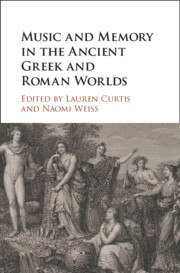21 results
Living with a blood cancer in later life: The complex challenges and related support needs of adults aged 75 and older
-
- Journal:
- Palliative & Supportive Care , First View
- Published online by Cambridge University Press:
- 22 August 2023, pp. 1-7
-
- Article
-
- You have access
- Open access
- HTML
- Export citation
Note on Texts and Abbreviations
-
- Book:
- Music and Memory in the Ancient Greek and Roman Worlds
- Published online:
- 14 October 2021
- Print publication:
- 28 October 2021, pp xv-xvi
-
- Chapter
- Export citation
Figures
-
- Book:
- Music and Memory in the Ancient Greek and Roman Worlds
- Published online:
- 14 October 2021
- Print publication:
- 28 October 2021, pp vii-x
-
- Chapter
- Export citation
Part II - Music, Body, and Textual Archives
-
- Book:
- Music and Memory in the Ancient Greek and Roman Worlds
- Published online:
- 14 October 2021
- Print publication:
- 28 October 2021, pp 63-120
-
- Chapter
- Export citation
Part III - Technologies of Musical Memory
-
- Book:
- Music and Memory in the Ancient Greek and Roman Worlds
- Published online:
- 14 October 2021
- Print publication:
- 28 October 2021, pp 121-172
-
- Chapter
- Export citation
Copyright page
-
- Book:
- Music and Memory in the Ancient Greek and Roman Worlds
- Published online:
- 14 October 2021
- Print publication:
- 28 October 2021, pp iv-iv
-
- Chapter
- Export citation
Contents
-
- Book:
- Music and Memory in the Ancient Greek and Roman Worlds
- Published online:
- 14 October 2021
- Print publication:
- 28 October 2021, pp v-vi
-
- Chapter
- Export citation
Part IV - Audience, Music, and Repertoire
-
- Book:
- Music and Memory in the Ancient Greek and Roman Worlds
- Published online:
- 14 October 2021
- Print publication:
- 28 October 2021, pp 173-258
-
- Chapter
- Export citation
Introduction
- from Part I - Approaching Music and Memory
-
-
- Book:
- Music and Memory in the Ancient Greek and Roman Worlds
- Published online:
- 14 October 2021
- Print publication:
- 28 October 2021, pp 3-24
-
- Chapter
- Export citation
Chapter 8 - Performance, Memory, and Affect
- from Part IV - Audience, Music, and Repertoire
-
-
- Book:
- Music and Memory in the Ancient Greek and Roman Worlds
- Published online:
- 14 October 2021
- Print publication:
- 28 October 2021, pp 203-233
-
- Chapter
- Export citation
General Index
-
- Book:
- Music and Memory in the Ancient Greek and Roman Worlds
- Published online:
- 14 October 2021
- Print publication:
- 28 October 2021, pp 352-357
-
- Chapter
- Export citation
Bibliography
-
- Book:
- Music and Memory in the Ancient Greek and Roman Worlds
- Published online:
- 14 October 2021
- Print publication:
- 28 October 2021, pp 311-351
-
- Chapter
- Export citation
Index Locorum
-
- Book:
- Music and Memory in the Ancient Greek and Roman Worlds
- Published online:
- 14 October 2021
- Print publication:
- 28 October 2021, pp 358-364
-
- Chapter
- Export citation
Part I - Approaching Music and Memory
-
- Book:
- Music and Memory in the Ancient Greek and Roman Worlds
- Published online:
- 14 October 2021
- Print publication:
- 28 October 2021, pp 1-62
-
- Chapter
- Export citation
Acknowledgments
-
- Book:
- Music and Memory in the Ancient Greek and Roman Worlds
- Published online:
- 14 October 2021
- Print publication:
- 28 October 2021, pp xiii-xiv
-
- Chapter
- Export citation
Contributors
-
- Book:
- Music and Memory in the Ancient Greek and Roman Worlds
- Published online:
- 14 October 2021
- Print publication:
- 28 October 2021, pp xi-xii
-
- Chapter
- Export citation
Part V - Music and Memorialization
-
- Book:
- Music and Memory in the Ancient Greek and Roman Worlds
- Published online:
- 14 October 2021
- Print publication:
- 28 October 2021, pp 259-310
-
- Chapter
- Export citation

Music and Memory in the Ancient Greek and Roman Worlds
-
- Published online:
- 14 October 2021
- Print publication:
- 28 October 2021
THE MEDEA - J. Mossman (trans.) Euripides: Medea. (Aris & Phillips Classical Texts.) Pp. viii + 392. Oxford: Oxbow Books, 2011. Paper, £24.99 (Cased, £50). ISBN: 978-0-85668-788-4 (978-0-85668-783-9 hbk).
-
- Journal:
- The Classical Review / Volume 66 / Issue 1 / April 2016
- Published online by Cambridge University Press:
- 03 November 2015, pp. 39-41
- Print publication:
- April 2016
-
- Article
- Export citation
THE TRAGIC CHORUS - R. Gagné, M.G. Hopman (edd.) Choral Mediations in Greek Tragedy. Pp. x + 429, ills, maps. Cambridge: Cambridge University Press, 2013. Cased, £65, US$110. ISBN: 978-1-107-03328-3.
-
- Journal:
- The Classical Review / Volume 65 / Issue 1 / April 2015
- Published online by Cambridge University Press:
- 13 November 2014, pp. 25-27
- Print publication:
- April 2015
-
- Article
- Export citation

